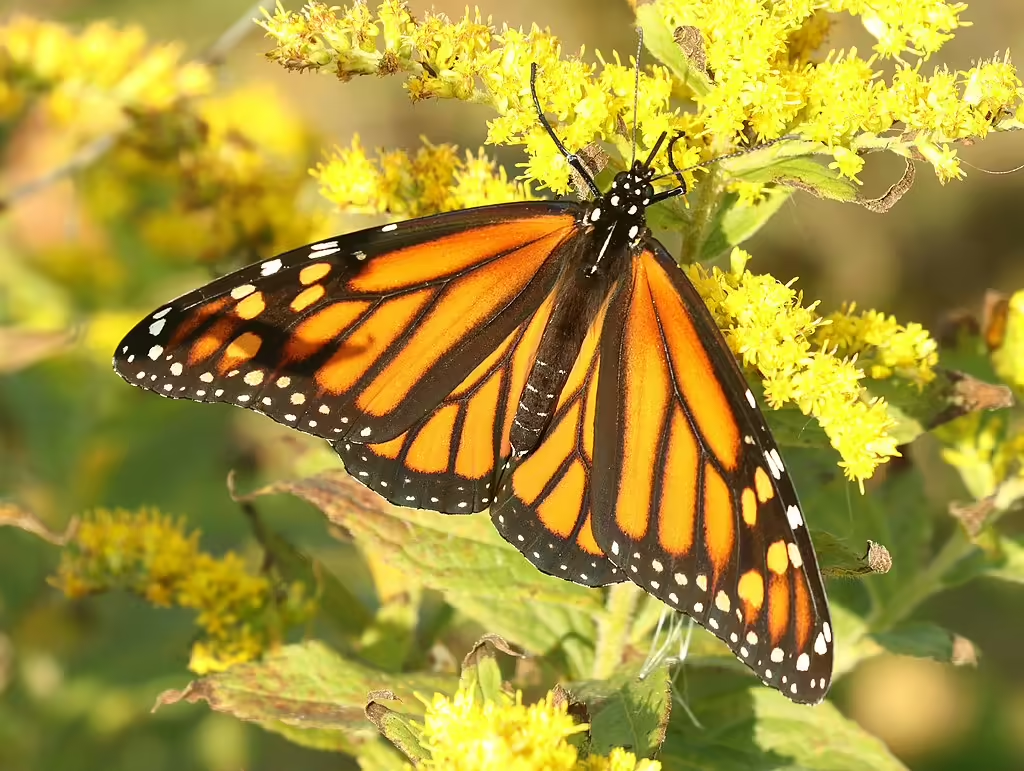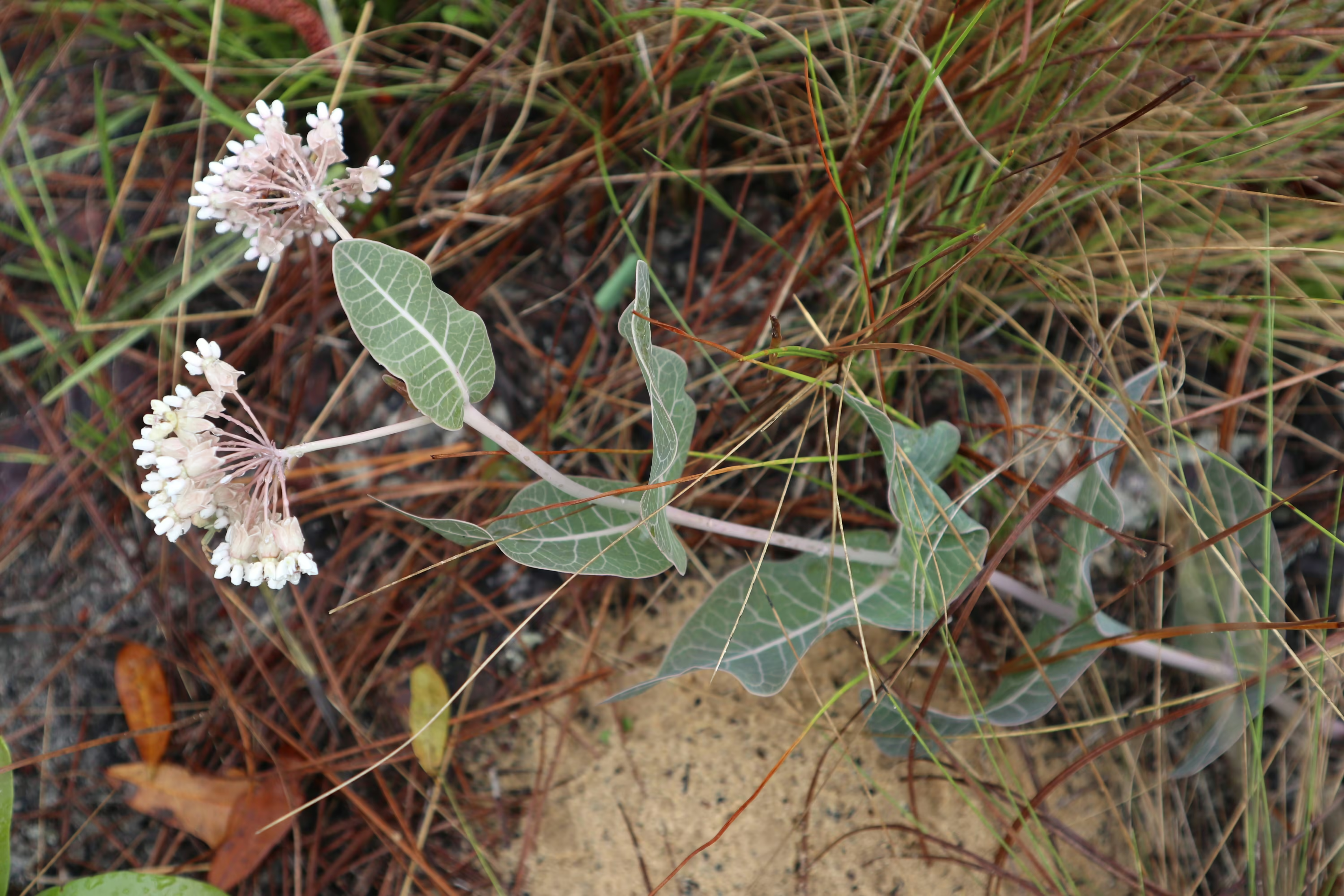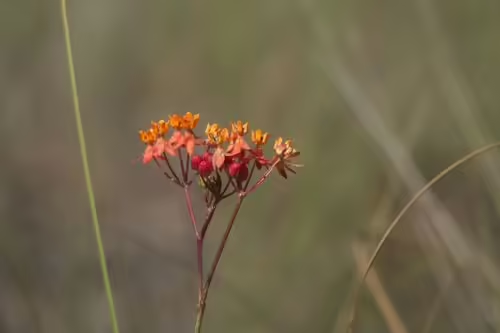Table of Contents for Wilmington, North Carolina Milkweeds
There are six species of milkweeds (Asclepias spp.) that are native to the Wilmington, NC area and can be grown for Monarchs and other butterflies such as Queen and Soldier butterflies. The Monarch butterfly in particular uses the cardenolides found in the milky sap of milkweeds to give an unpleasant taste to predators. These plants are also an important nectar source to all insects visiting your pollinator garden. Seeds for a number of these native Wilmington milkweeds can be found in the garden shop.
Location of the Wilmington, North Carolina Metro Area

Wilmington, NC Metro area is colored in red and includes the counties of Brunswick, New Hanover, and Pender in the southeast part of the state. The species covered in this post grow in all parts of the Metro area.
USDA Plant Hardiness Zones in Wilmington, North Carolina

Most of the Wilmington, NC area is located in Zone 8b, with the northern half of Pender County in Zone 8a. When selecting plants within the City of Wilmington you will want to those species that can handle temperatures as cold as +15F to be sure they survive.
Butterflies in Wilmington that are Hosted by Milkweeds (Asclepias spp.)


Monarch Butterfly (Danaus plexippus)
The monarch butterfly is one of the most iconic butterflies in North America and is a bellweather of the environment. Having a distinctive orange color with black stripes, this butterfly has a wingspan of 3 in (7.6 cm) to 5 in (12.7 cm). The monarch butterfly ingests the toxic cardenolides of the milkweed plants, making it distasteful to predators. It can have several flights in a year and is known for its migrations to Mexico each year. However, some populations in southern California, Arizona, and Florida do not migrate and breed year-round (Urguhart, et al 1968).
Queen Butterfly (Danaus gilippus)
The queen butterfly is similar to the Monarch Butterfly but is more of a solid orange in color and has a brownish hue. When the wings are closed (the underside), it looks very similar and is hard to tell apart. It is smaller than the Monarch having a wingspan of 2.5 in (6.4 cm) to 4 in (10.2 cm). The Queen Butterfly is a mimic of the monarch, but it also ingests the cardenolides of the milkweed plants. In the south, this butterfly can breed year-round, but in the north it breeds from April to November. This species, unlike the monarch, does not migrate.
Soldier Butterfly (Danaus eresimus)
The soldier butterfly, at least on the upperside, looks a lot like the queen butterfly, but it is more of a reddish-brown color and has white spots only on the topside, versus both sides on the queen (Wikipedia). The soldier butterfly is also smaller than the monarch butterfly and is roughly the size of the queen butterfly having a wingspan of 2.5 in (6.4 cm) to 3.5 in (8.9 cm). The flights of this butterfly are generally year-round, but it is seen most in the autumn and early winter.
List of Milkweeds that are Native or Nearly Native in the Wilmington, NC Area
1. Clasping Milkweed (Asclepias amplexicaulis), a Milkweed for Sandy Soils
Clasping Milkweed (Asclepias amplexicaulis): Clasping milkweed is found throughout North Carolina (Kartesz 2015). In the wild, clasping milkweed grows in dry woodlands, prairies, meadows, and roadsides that have sandy or gravelly soil. Growing up to 3 feet tall, this milkweed has greenish-pink, red, brown, to purple flowers that bloom from March to September.
In your Wilmington butterfly garden, this milkweed is hardy in zones 3-9 and requires full sun to part-shade and moist to dry sandy soils. Seeds of clasping milkweed can be purchased in the McMullen House Bed & Breakfast Garden Shop.



2. Sandhill Milkweed (Asclepias humistrata), a Milkweed for Sandy Soil
Sandhill Milkweed (Ascelpias humistrata): Sandhill milkweed is native mainly to the eastern Piedmont and Coastal Plain in the southeastern counties of North Carolina (Kartesz 2015). A few isolated occurrences are located in the middle Piedmont. In the wild, sandhill milkweed grows, as the name suggests, on sandhills, but it also can found in dry oak woods, pine barrens, as well as roadsides. Growing from 1 to 3 feet tall, the flowers are white, pink, or purple and bloom from April to July.
In your Wilmington butterfly garden, this milkweed is hardy in zones 8-9 and requires full sun and mesic to dry sandy soil. In a garden it can also handle part-shade conditions. Seeds of sandhill milkweed can be purchased in the McMullen House Bed & Breakfast Garden Shop.



3. Swamp Milkweed (Asclepias incarnata), a Milkweed for Moist Soils
4. Swamp Milkweed (Asclepias incarnata): Swamp milkweed has two subspecies, ssp. incarnata and ssp. pulchra. Only ssp. pulchra is found in the mountains (western), Piedmont (central), and the northern Coastal Plain (Kartesz 2015). Like the name suggests swamp milkweed grows in wet places such as the shores of streams, lakes, ponds, and other wetlands. However, as a landscape plant it can exist in drier places. The flowers are variable and are generally a pink to red color, but there is also a white cultivar (pictured below).
In your Wilmington butterfly garden, subsp. pulchra is hardy in zones 4-9 and requires full sun to partial-shade and well-drained soil. While this species is not native to the Wilmington area it is nearby and can exist in the plant hardiness zone of Wilmington. Seeds of swamp milkweed can be purchased in the McMullen House Bed & Breakfast Garden Shop.



4. Few-flower Milkweed (Asclepias lanceolata), a Milkweed for Moist Soils
Few-flower Milkweed (Ascelpias lanceolata): Few-flower milkweed is native to the Coastal Plain on the coast of North Carolina (Kartesz 2015). In the wild, few-flower milkweed grows on the edges of marshes, wet pine barrens, savanna, and glades. Growing from 2 to 5 feet tall, it has flowers that are generally orange to red, but can be yellow or red-purple and bloom from May to August.
In your Wilmington butterfly garden, this milkweed is hardy in zones 5-11 and requires full sun to part-shade in soil that is loamy and moist to wet.



5. Long-leaf Milkweed (Asclepias longifolia), a Milkweed for Moist Soils
Long-leaf Milkweed (Ascelpias longifolia): Long-leaf milkweed is native and rare in the Coastal Plain of North Carolina (Kartesz 2015). Long-leaf milkweed has two varieties, one of which, Asclepias longifolia var. longifolia, is found in North Carolina. In the wild, this milkweed grows in moist areas and wetlands such as bogs, swamps, and wet flatwoods. Growing from 1 to 2.5 feet tall, the flowers are often greenish-white with a purple tinge and bloom from April to July.
In your Wilmington butterfly garden, variety longifolia is hardy in zones 4-9 and requires full sun and moist to wet soils. Long-leaf milkweed is a rare species in North Carolina that may not be in cultivation.



6. Savannah Milkweed (Asclepias pedicellata), a Milkweed for Sandy Soil
Savannah Milkweed (Ascelpias pedicellata): Savannah milkweed is native and rare in the southeastern Coastal Plain of North Carolina (Kartesz 2015). In the wild, savannah milkweed grows in long-leaf pine flatwoods and savannas that have a fire ecology. Growing from 0.5 to 1.5 feet tall, the flowers bloom from May to July and have a yellow, green to creamy white color.
In your Wilmington butterfly garden, this milkweed is hardy in zones 7-10 and requires full sun and mesic to moist sandy soil. Savannah milkweed is rare in North Carolina and may not be in cultivation.



7. Purple Milkweed (Asclepias purpurascens), a Milkweed for Moist Soils
Purple Milkweed (Asclepias purpurascens): Purple milkweed is native and while considered rare, it is scattered in all regions of North Carolina (Kartesz 2015). In the wild, purple milkweed can tolerate full sun to part shade and is found in swamps, woodlands, meadows, and roadsides. Growing up to 6 feet tall, it is one of the taller milkweeds in North Carolina, and has flowers, as the name suggests that are generally purple, but it can range from rose to pink, or may start out pink and mature to purple. Blooming occurs from May to July.
In your Wilmington butterfly garden, this milkweed is hardy in zones 3-8 and generally requires part-shade, but handle full sun if needed. Soils should be moist and well-drained, but dry soil can be tolerated. Seeds for this plant can be purchased in the McMullen House Bed & Breakfast Garden Shop.
Purple milkweed is considered to be rare in North Carolina and is at the southern limit of its range and plant hardiness zone in the Wilmington area. With climate change it is likely that this species will not be able to be grown in Wilmington. It is included here since it may still be possible to grow this species in Wilmington.



8. Red Milkweed (Asclepias rubra), a Milkweed for Moist to Wet Soils
Red Milkweed (Asclepias rubra): Red milkweed is located mainly in the eastern Piedmont and Coastal Plain of North Carolina (Kartesz 2015) with one disjunct occurrence in the western Piedmont. In the wild, red milkweed grows in wet open areas such as meadows, bogs, and pine barrens. Growing from 1 to 3 feet tall, the flowers range from pink, purple, red, lavender in color and bloom from May to August.
In your Wilmington butterfly garden, this milkweed is hardy in zones 6-9 and it prefers places where it can enjoy full sun or part-shade and wet organic soils.



9. Common Milkweed (Asclepias syriaca), a Milkweed for all Soils
Common Milkweed (Asclepias syriaca): Common milkweed is located throughout North Carolina, except for the southeast (Kartesz 2015). In the wild, common milkweed grows in open areas such as fields, pastures, and roadsides, where it can receive full sun. Growing up to 6 feet tall, it is a tall milkweed having flowers ranging from pink, greenish-purple, greenish-white, to white and bloom from June to August.
In your North Carolina butterfly garden, this milkweed is hardy in zones 3-9 and requires full sun to part-shade and any type of soil. As the name implies, this is one of the most common and important milkweed species for the Monarch butterfly. Seeds of common milkweed can be purchased in the McMullen House Bed & Breakfast Garden Shop. This milkweed is native north of Wilmington, but can grow in its plant hardiness zone. It is known for very flexible in garden conditions.



10. Velvetleaf Milkweed (Asclepias tomentosa), a Milkweed for Sandy Soils
Velvetleaf Milkweed (Asclepias tomentosa): Velvetleaf milkweed is located in the Sandhills of North Carolina and adjacent regions (Kartesz 2015). In the wild, velvetleaf milkweed grows in sandy pine woodlands with long-leaf pine (Pinus palustris) and scrub oak sandhills. Growing from 2 to 3 feet tall, it has flowers ranging from yellow-cream with pink to maroon tints that bloom from April to August.
In your Wilmington butterfly garden, this milkweed is hardy in zones 7-10 and requires full sun and mesic to dry sandy soils. Seeds of velvetleaf milkweed can be purchased in the McMullen House Bed & Breakfast Garden Shop. This milkweed is at the northern limit of its range and is considered to be rare in North Carolina. However, with climate change conditions may become more favorable for it in the future. Because it is rare, it may be difficult to find in nurseries.



11. Butterfly Weed (Asclepias tuberosa), a Milkweed for all Soils
Butterfly Weed (Asclepias tuberosa): Butterfly weed is one of the most common for butterfly gardeners on the east coast of the United States. In North Carolina, subspecies rolfsii and tuberosa occur. The former has a limited range and the latter essentially occurs throughout the state (Kartesz 2015). In the wild, this milkweed grows in open areas with full sun such as fields, roadsides, and open woods. Growing from 1 to 3 feet tall, it has characteristically orange flowers that bloom throughout the summer and sometimes into the autumn.
In your Wilmington butterfly garden, this milkweed is hardy from zones 3-9 and requires full sun in any type of soil condition. This is one of two milkweeds in North America that does not have a milky sap. Seeds of butterfly weed can be purchased in the McMullen House Bed & Breakfast Garden Shop.



12. Red-ring Milkweed (Asclepias variegata), a Milkweed for Dry Sandy Soils
Red-Ring Milkweed (Asclepias variegata): Red-ring milkweed is located throughout North Carolina (Kartesz 2015). In the wild, red-ring milkweed grows in open disturbed areas such as thickets and roadsides. Growing 1 to 4 feet tall, it has white colored flowers with a ring of purple to red that bloom from May to July.
In your Wilmington butterfly garden, this milkweed is hardy in zones 3-9 and prefers part-sun to light-shade and dry sandy or rocky soils. Seeds of red-ring milkweed can be purchased in the McMullen House Bed & Breakfast Garden Shop.



13. Whorled Milkweed (Asclepias verticillata), a Milkweed for Medium to Dry Soil
Whorled Milkweed (Asclepias verticillata): Whorled milkweed is located in the Piedmont and mountain regions of North Carolina (Kartesz 2015). In the wild, whorled milkweed grows in open areas such as meadows and fields, where it can take advantage of full sun. Growing from 1 to 3 feet tall, it has green to white flowers that bloom from May to September.
In your Wilmington butterfly garden, this milkweed is hardy in zones 3-9 and requires full sun to part-shade with medium to dry soil. This milkweed is native to the northwest and south of Wilmington and along the coast of South Carolina. While not native to the area it potentially could be considered for your garden. Seeds of whorled milkweed can be purchased at the McMullen House Bed & Breakfast Garden Shop.



14. Green Comet Milkweed (Asclepias viridiflora), a Milkweed for Medium to Dry Sandy Soils
Green Comet Milkweed (Asclepias viridiflora): Green comet milkweed is located generally in the central (Piedmont) and northeastern Coastal Plain of North Carolina (Kartesz 2015). In the wild, green comet milkweed grows in open areas such as meadows and field where there is full sun. Growing up to 3 feet tall, it has flowers, which bloom from June to August, that begin as a green color but age to become yellow with a purple tinge.
In your North Carolina butterfly garden, this milkweed is hardy in zones 3-9 and requires full sun to part-shade with medium to dry sandy soil. This milkweed, like the whorled milkweed, is native to the northwest of Wilmington. However, since it is at the edge of the plant hardiness zone, it may not last long with climate change. Seeds of green comet milkweed can be purchased at the McMullen House Bed & Breakfast Garden Shop.



When selecting your Wilmington milkweed, be sure to make sure that it grows in your zone and habitat.
References for Wilmington Milkweeds
- Kartesz, J.T., The Biota of North American Program (BONAP). 2015. Taxonomic Data Center. Link to website. Chapel Hill, N.C. [maps generated from Kartesz, J.T. 2015. Floristic synthesis of North America, Version 1.0. Biota of North America Program (BONAP). (in press)]
- Urguhart, Frederick Albert, Norah Roden Urguhart, and Francis Munger. 1968. Population of Danaus plexippus in Southern California. Journal of Research on the Lepidoptera 7(4): 169-181.
